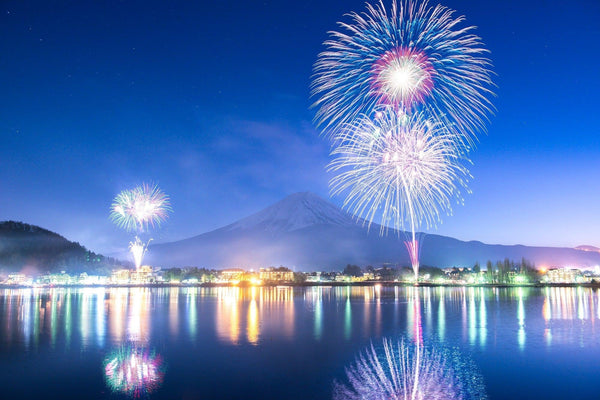
Jump to:
Arguably one of the greatest things about Japanese culture is its summer festivals (natsu matsuri). This is where locals (and foreigners, too) can let loose and have fun! There are actually thousands of matsuri (festivals) in Japan every summer. There are several different types of summer festivals, too. This article will go into what Japanese summer festivals are, a bit about their history, which ones to go to, and more.
What Is A Japanese Summer Festival?

A summer festival in Japan is called natsu matsuri. Natsu means summer, and matsuri is an annual (usually) Japanese festival that is similar in many ways to festivals in the West. In Japan, summer festivals have both traditional and modern elements (depending on the event). Often they have religious roots, as well, although these are not always top of mind in modern times.
Natsu matsuri may focus on a god or temple, a holiday or season, or bringing good luck. Others may be more about the dancing and music, the fireworks or just having fun! Some are even about fertility, naked men or some more private body parts (yes, really).
Depending on the type of Japanese summer festival you go to, you will see different types of Japanese food and clothing, perhaps a mikoshi (a portable shrine carried on the shoulders of participants) or you might even hear unique Japanese chants from the crowd.
Matsuri History
According to OnTrip (a Japanese magazine by Japan Airlines), the word matsuri (festival) originally meant “to enshrine.” So the original word, matsuri, does have a religious background. The festivals originally occurred around the changing of the seasons. OnTrip said, “This [was] deeply related to the cycle of life, and people pray[ed] to the gods of the land, such as ‘May we harvest a lot of rice in farming villages,’ and ‘May we harvest a lot of fish’ in fishing villages.”
Although the festivals had religious roots, by the Edo period (1603–1867) Japanese festivals were becoming not only a religious thing, but also a way to have fun and get to know the local community. And that continues on into the current era — people might know the spiritual roots of a festival, but it may not be the main reason they go.
Summer Festival Activities: So Many To Choose From!
There are all kinds of activities at summer festivals — you can dance, eat, drink and more. Here are some of the most popular things to do at Japanese matsuri.
Dance: The Old and the New

The dance you’re most likely to see at a summer festival in Japan is called bon odori. It’s a traditional Japanese dance, and you will probably see dancers and drummers on a yagura (like a high platform or stage) in the center of the festival. Other people dance around the yagura in a circle. Some people at the festival are good at the bon odori dance, and others have no skill at all — so don’t worry about messing up if you decide to try dancing yourself. Just have fun!
Another highly recommended dance festival is called yosakoi. This one doesn’t have such a long history, and combines traditional and modern elements — it’s very creative. Groups of dancers wear really colorful costumes and dance forward down a path to the music. They use wooden instruments (clappers) called naruko. Definitely check this festival out if you get the chance.
Festival Food: Something For Everyone

You will find all kinds of Japanese street food at matsuri in Japan — everything from noodles to cotton candy to chocolate-covered bananas! Here are a few really great (and pretty easy to find) summer festival foods.
- Yakisoba - This stir fried noodle dish is fantastic. It’s usually fried up with meat, veggies and sauce. And, although soba is in the name, soba noodles aren’t actually used in this dish — they’re more like a Chinese-style wheat noodle. See how yakisoba is made at a matsuri on YouTube or try making it yourself with our recipe.
- Hiyashi Kyuri - A fairly simple snack — hiyashi kyuri is basically just a marinated cucumber on a stick. They taste similar to pickles, but much more fresh and crisp (in Japanese, you could describe the sensation when you eat it as pori pori).
- Kakigori - Well, it’s a summer festival in Japan, and you know summer in Japan is hot. So, of course there’s a perfect treat to keep you cool - kakigori! It’s shaved ice topped with different flavored syrups and toppings.
- Choco Banana - This is as simple as it sounds — a banana covered in chocolate on a stick. They come in different colors with different decorations, too.
- Potato Fry - Although in Japanese they say poteto furai or furaido poteto, it’s basically what we Westerners call french fries. They’re very popular, though, and sometimes you can choose your own seasonings.
- Baby Castella - If you like castella (the popular Japanese cake), you’ll probably love baby castella, too. It’s a smaller, different-shaped version of traditional castella. It sort of tastes like egg puffs, if you’ve had those before. There’s another variation, too, called suzu castella (they’re shaped like bells).
- Takoyaki - These are at most festivals you go to — the famous octopus-filled, doughy fried balls. These are covered in takoyaki sauce that is quite similar in flavor to okonomiyaki sauce.
Drinks: Pop the Marble!

There are many types of drinks available at summer festivals — often assorted bottled drinks (juices, water, sports drinks, etc.) on ice in a bucket or water cooler. Many (but not all) festivals have beer, too. One recommendation: Ramune soda. Make sure to get the glass Ramune bottle — it has a marble as its seal! See this video to see why it’s so special. And, if you just want to see what Ramune soda tastes like, you can order the canned version here.
Games: Win a Goldfish

The games at Japanese summer festivals are a bit different from festivals in the West. A lot have a water element going on. Here are a few popular games you can play at the matsuri booths.
- Goldfish Catching (kingyosukui) - In this one there are goldfish (real ones!) in a small pool of water. You catch them using a flat paper scooper (called a poi). The poi will break once it gets too wet, so you catch as many fish as you can before it falls apart. Another game that is almost identical to this (except you fish for balls) is called Super Ball (supa boru).
- Smart Ball (sumato boru) - A game that combines elements of pinball and pachinko (the popular, almost-gambling game of Japan). Seeing it on YouTube would explain it best, but it involves getting balls into holes and getting a prize.
- Water Balloon Fishing (yo yo tsuri) - The water balloons in this game are decorated, partially filled with water and have a rubber band-like loop attached to them. They are placed in a small pool of water so they bob on the surface. You fish for them with a paper string with a hook at the end. What makes it challenging is that if the paper string gets too wet, it will break. The prize is the yo-yo water balloon itself, and you can bounce it like a yo-yo on your finger. Seeing is believing — check it out on video to understand it better.
- Shooting (shateki) - This game is in the West, too. It’s basically just shooting the prize you want with a cork gun. See it in action at a Japanese festival.
- Concentration or “Nervous Breakdown” (shinkei-suijaku) - This one is basically like concentration (also called memory) in the West. You flip picture cards (or pull ropes with balls at the end) and find the matching pairs.
Music: Living on a Prayer
Japanese summer festivals play all kinds of music — some more traditional and some more modern. At a Bon Odori (dance) festival, you might hear the famous coal-mining song, Tanko Bushi. At a more modern Bon Odori, you might hear Jon Bon Jovi (there is a pun at work here… bon Jovi like bon odori — see it on YouTube). There are even some famous songs about the festivals themselves, like the classic “Natsu Matsuri,” a more recent hit by ZONE and even a popular anime song, “Uchiage Hanabi” (“Launching Fireworks”).
Masks: A Good Omen?

A popular item at summer matsuri are masks (omen). But, why? Well, besides just being fun to wear, some say the tradition came from the Edo Period (1603–1867) when people would wear masks during theatrical performances. They started wearing the masks at festivals, too, and reenacting scenes from plays.
Another reason people wore masks was to please the gods — or even become a god themselves! Nowadays, though, they are mostly used for fun and maybe accessorizing with an outfit, but some of the masks have their own interesting backstories (a few of them quite dark). There are also some not-so-traditional masks around, like characters from Star Wars, Disney, Japanese anime and more.
Hanabi: The Fireworks!

Some Japanese summer festivals have fireworks — called hanabi in Japanese. According to Kokugakuin University, fireworks started in Japan’s Edo period for a surprisingly sad reason. “At that time in Kansai and Edo, many people died due to famine and epidemics. The Suijin Festival was held to commemorate the spirits of the dead and drive away the plague, and fireworks were set off for the first time.” Fortunately, the purpose of fireworks at festivals evolved into something much more fun and are not seen so darkly today. In fact, it can be quite romantic to go see fireworks at natsu matsuri with a date.
Festival Attire: What to Wear

At a summer festival in Japan, you can really wear whatever you’re comfortable in (as long as you aren’t part of a ceremony or working at the festival yourself). Your casual clothes are just fine. Japanese people usually attend wearing their relaxed summer attire, traditional clothing like a yukata or even their work clothes. Seriously, anything is okay — but if you’re happy and you know it, you could try wearing a happi (a traditional Japanese coat)!
Some Popular Japanese Summer Festivals
There are literally thousands of summer festivals in Japan, so how do you choose which one to go to? Here are a few famous ones that you might want to check out.
- Gion Matsuri, Kyoto - this is the most famous festival in Japan. It’s actually registered on the UNESCO Intangible Cultural Heritage of Humanity list. It features gigantic floats on wheels, plus the fascinating Shinto practice of selecting a “holy child” each year.
- Nebuta Matsuri, Aomori - This is one of the most unique festivals in Japan because of its glowing floats (nebuta) that parade down the street. According to the Aomori Nebuta festival committee, the nebuta are “...9 meters wide, 7 meters deep and 5 meters high, most of them resembling ancient warlords, historical characters and kabuki characters in early days.”
- Tenjin Matsuri, Osaka - A huge festival in Osaka, this one even goes down the Okawa River. It’s named as one of the top three festivals in Japan. See this YouTube video to learn more about it.
Tips for Attending Summer Festivals

- Plan Ahead - Search online for event calendars in the areas you want to visit. There are often listings of summer festivals. You can find out the best dates, times, and events to go to.
- Consider Traditional Japanese Clothing - You might think about getting a yukata if you really want to get into the spirit of things. This is a traditional Japanese garment, but it’s worn by people of all generations at summer festivals. Note: Some festivals have their own unique attire if you want to participate — check out their websites for more information.


0 comments